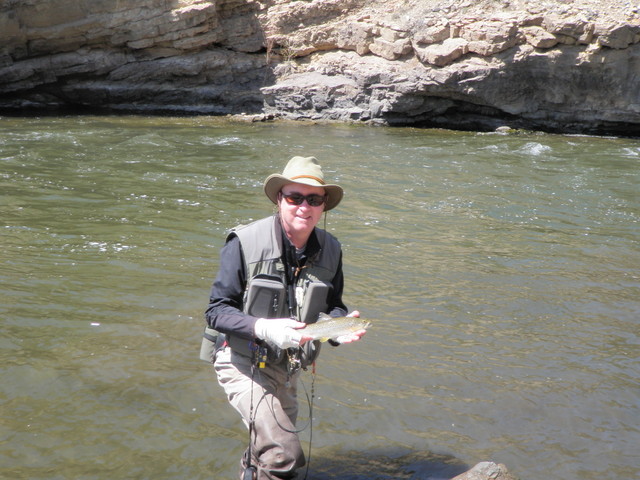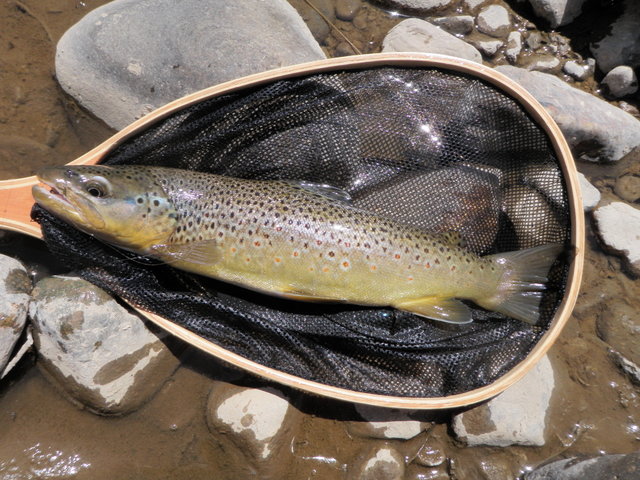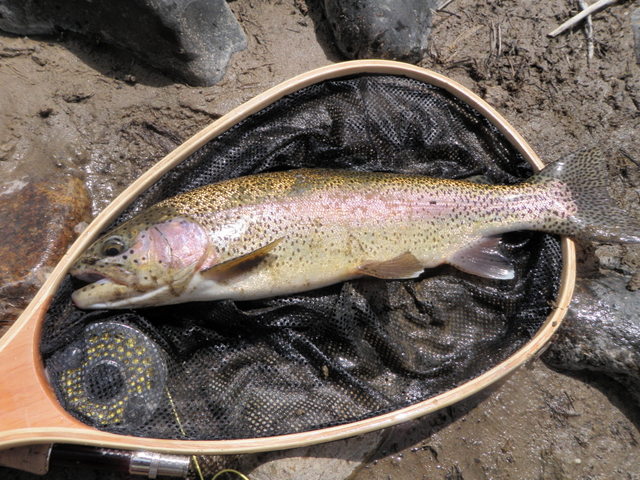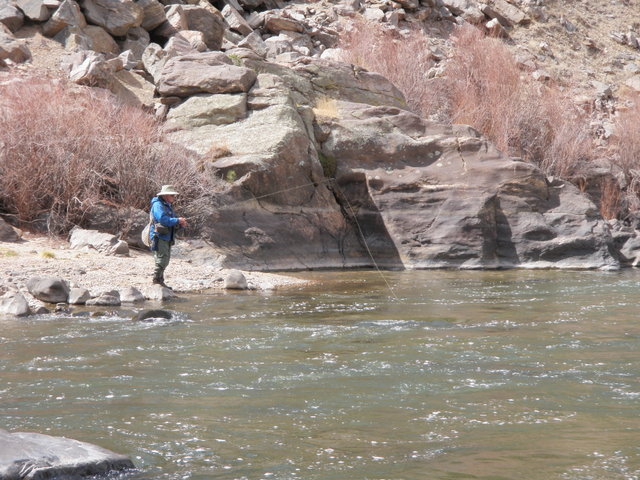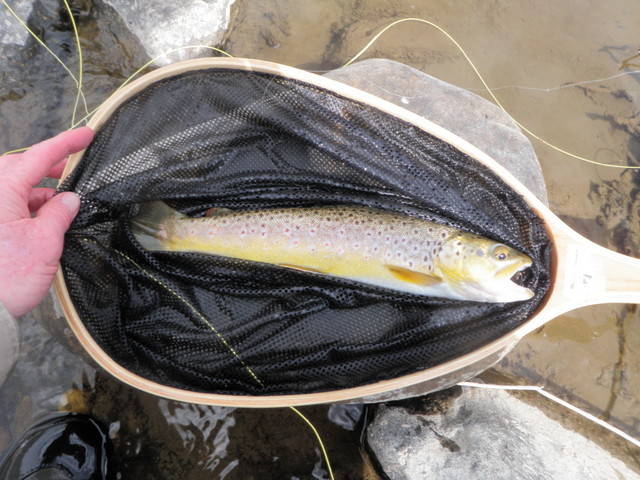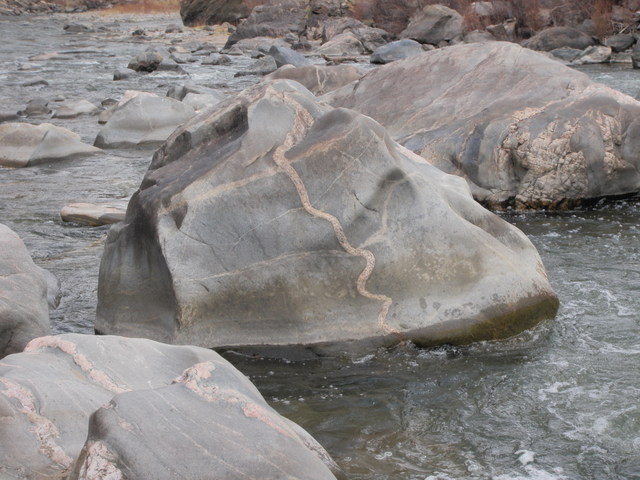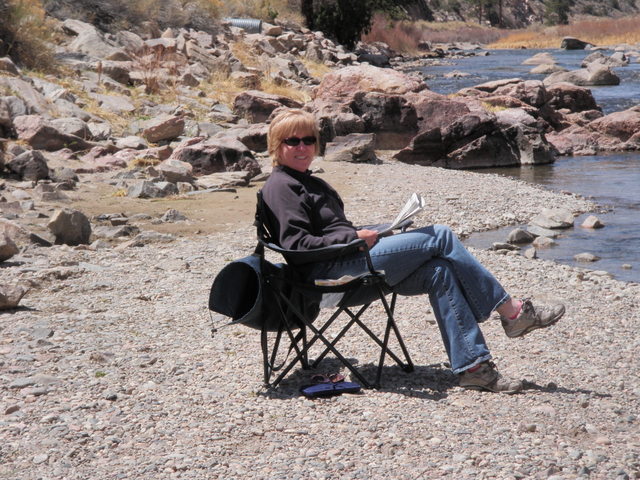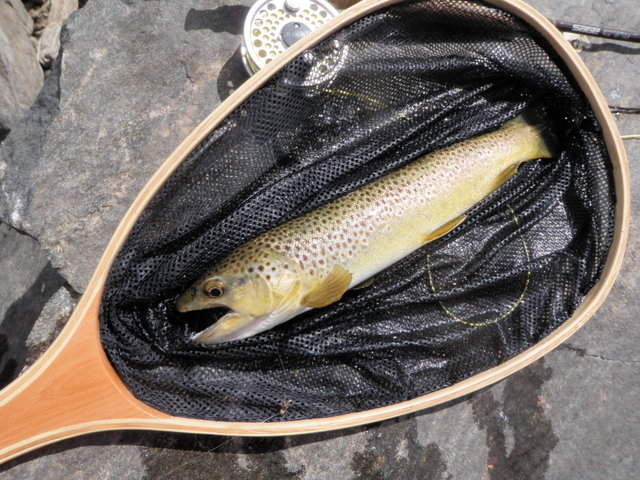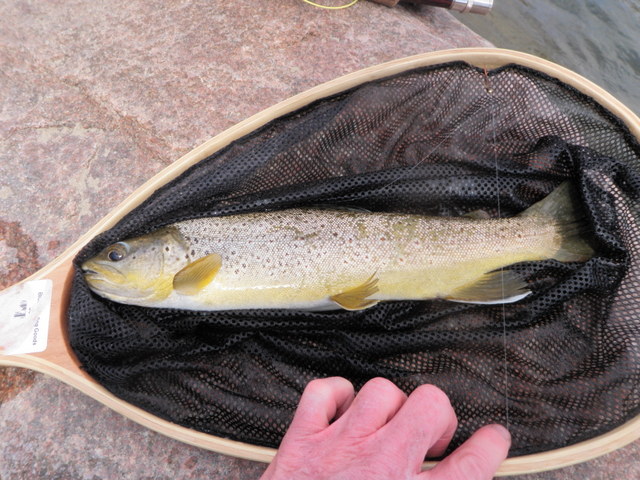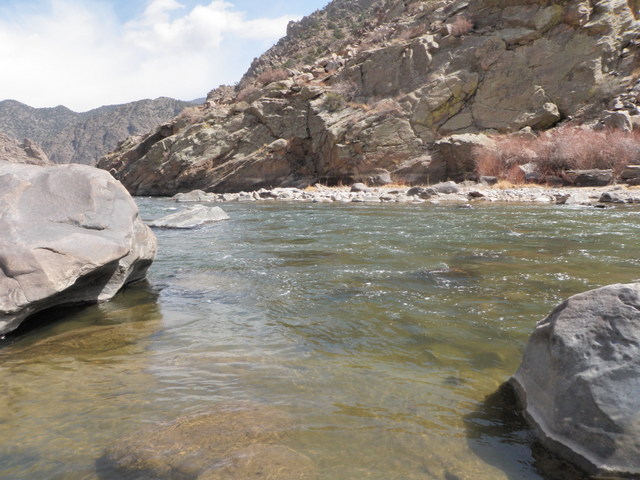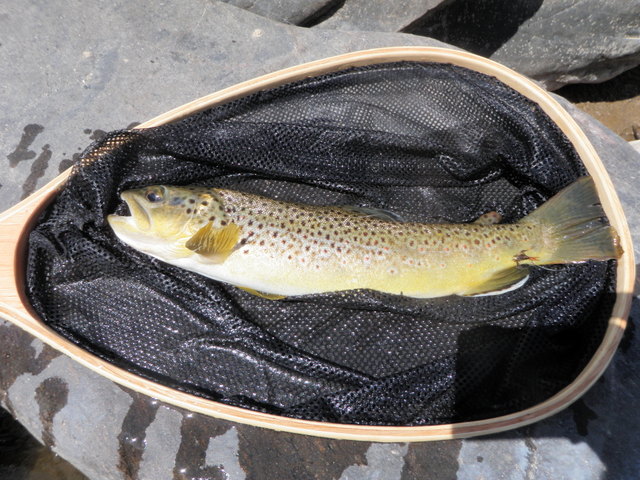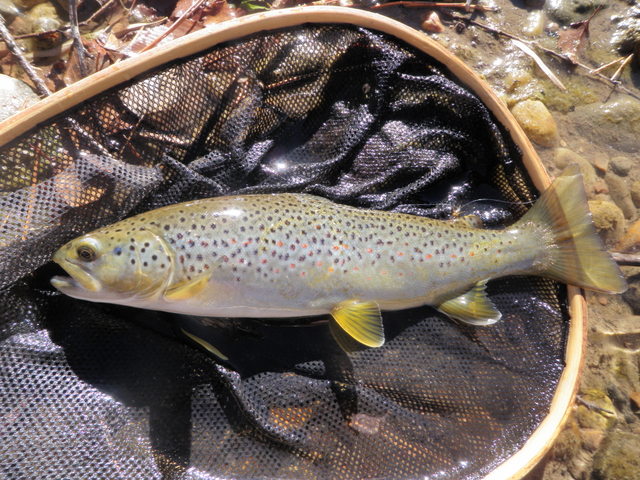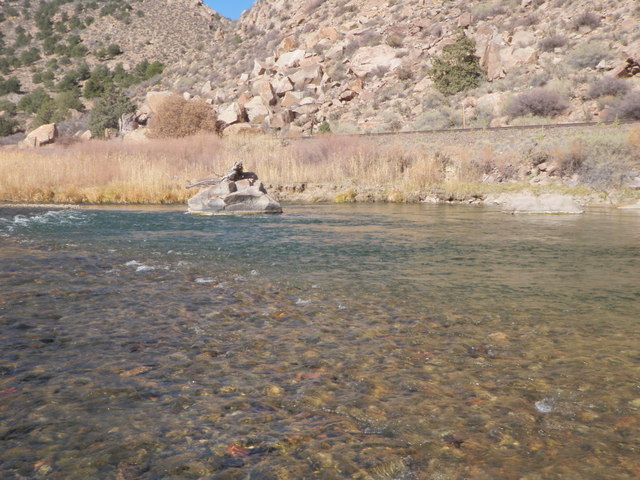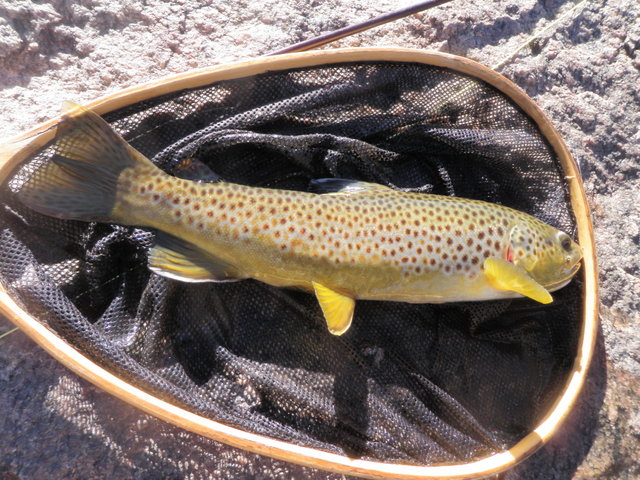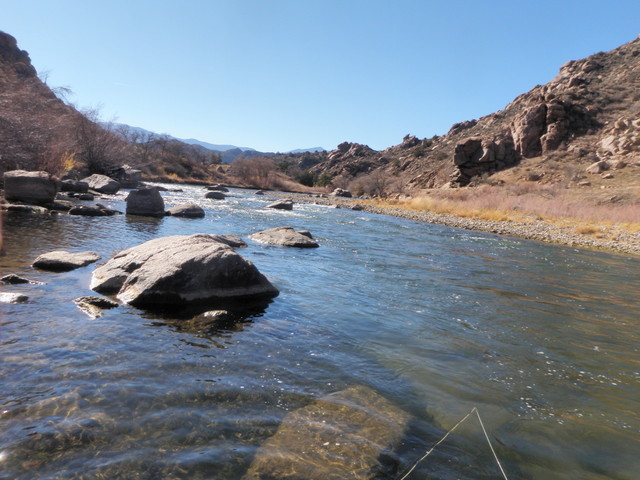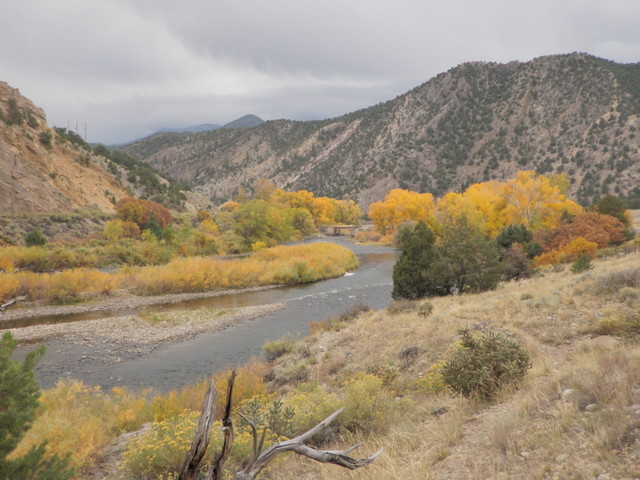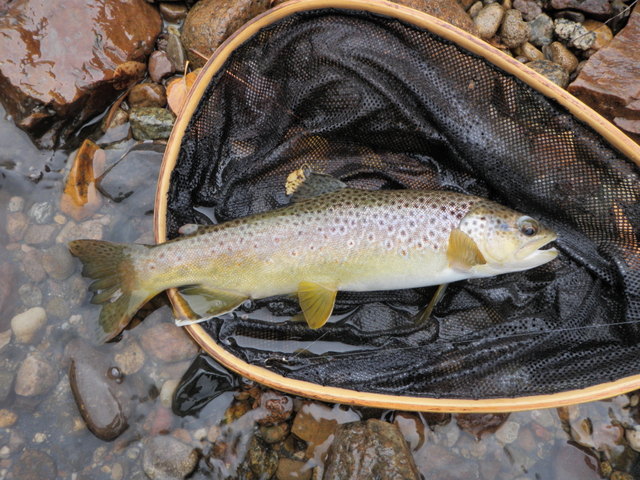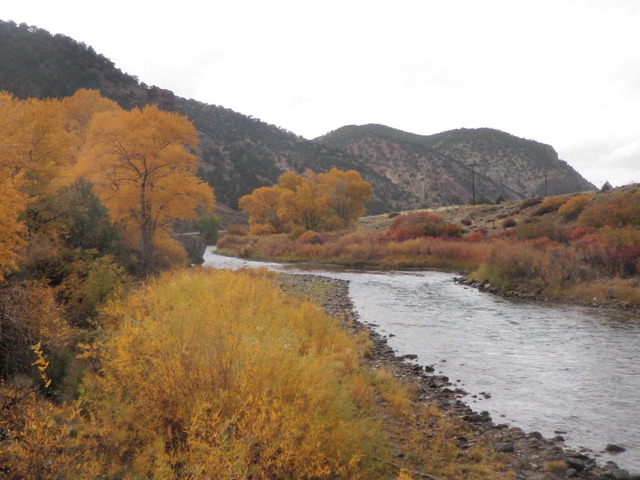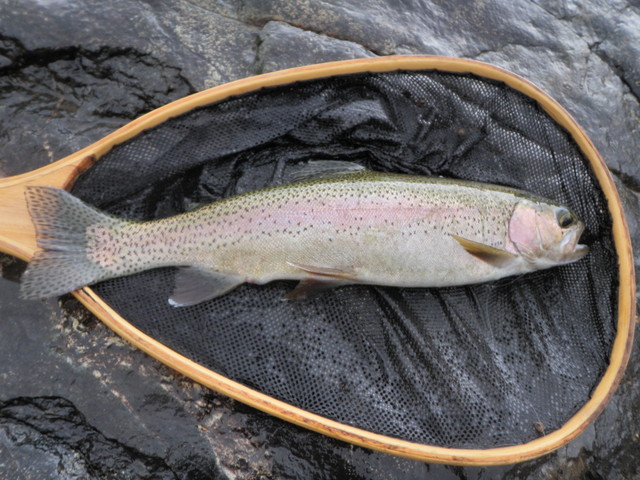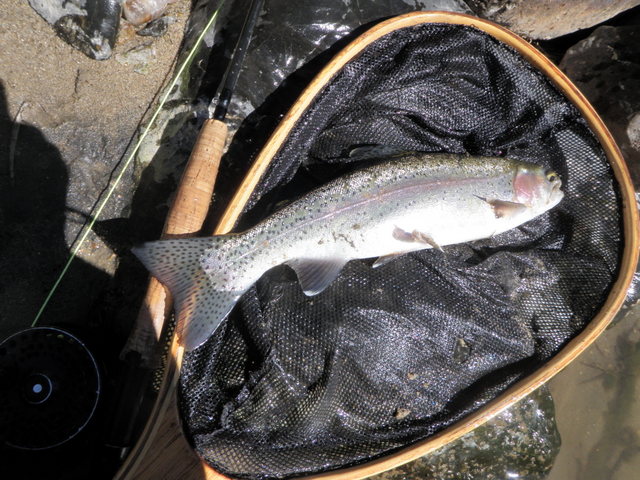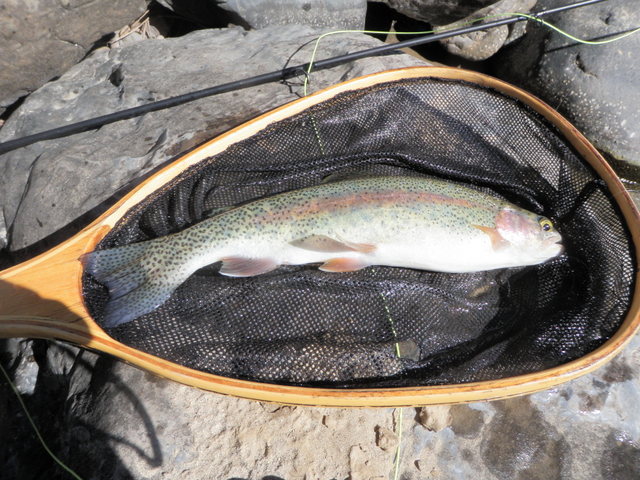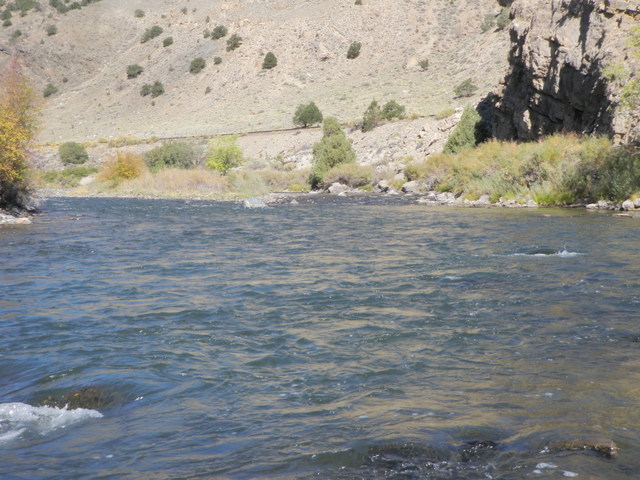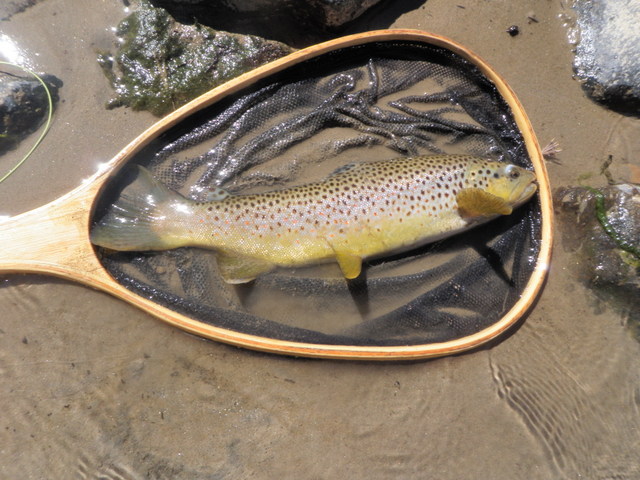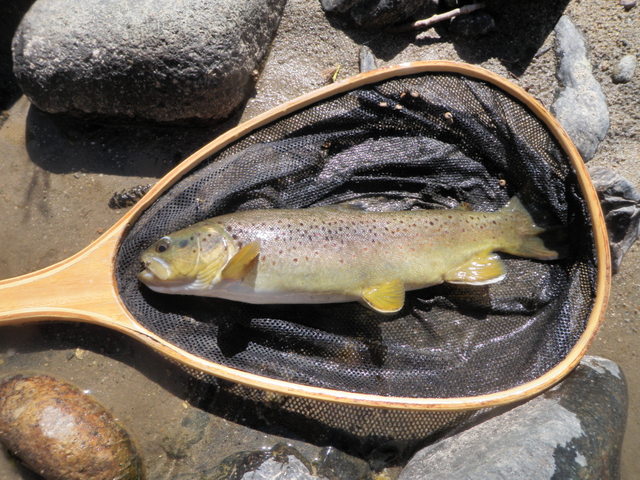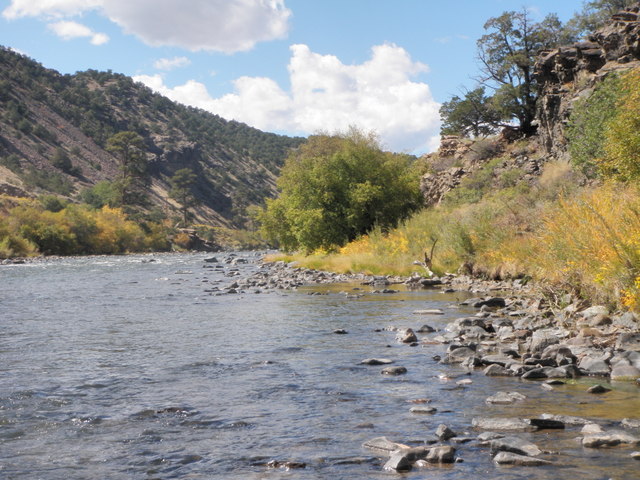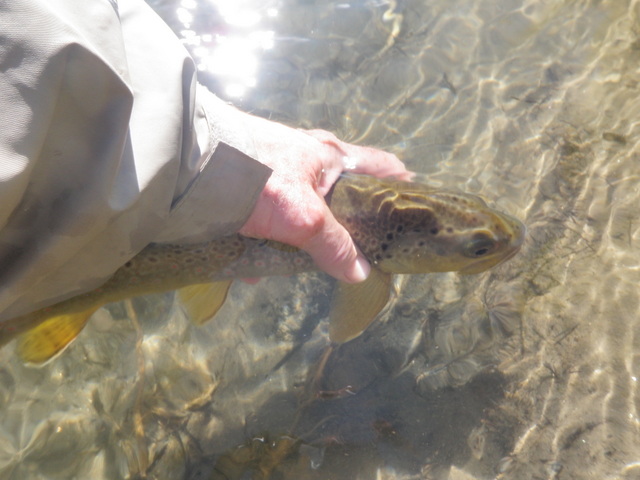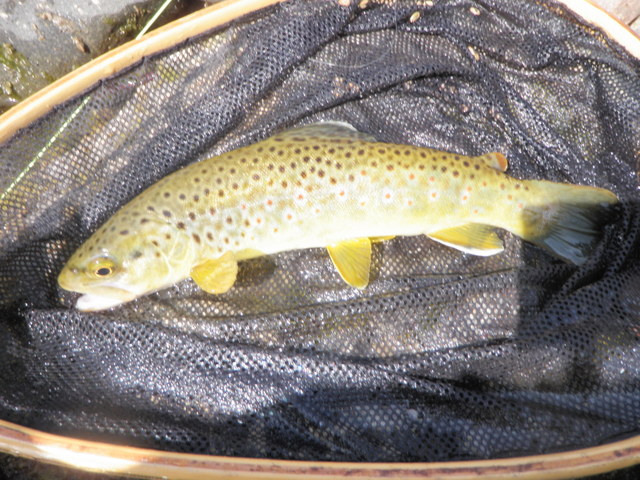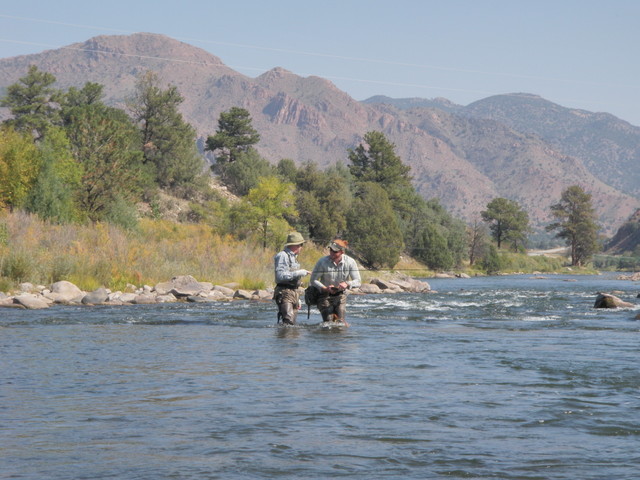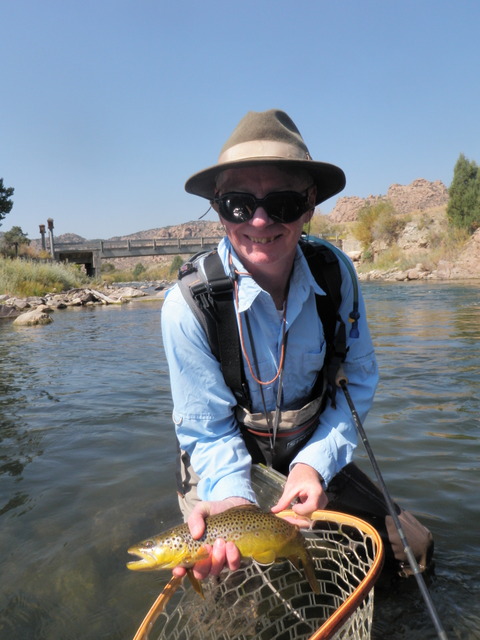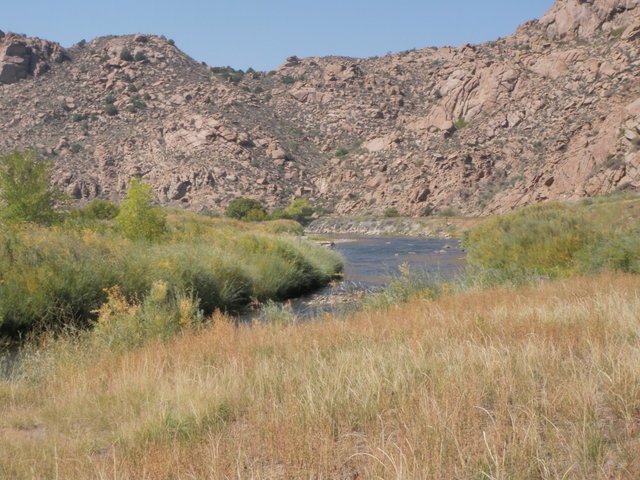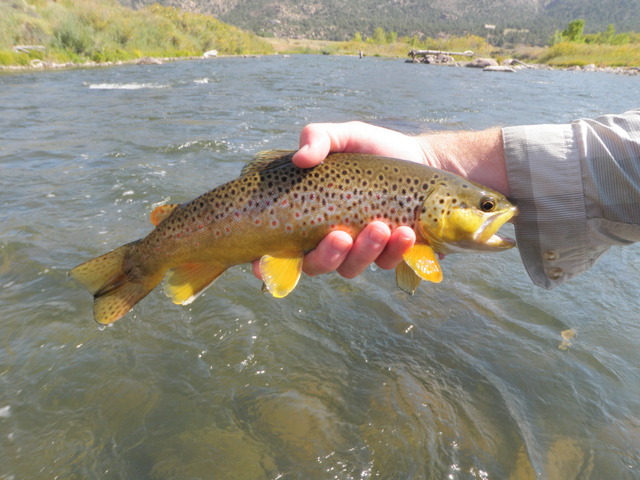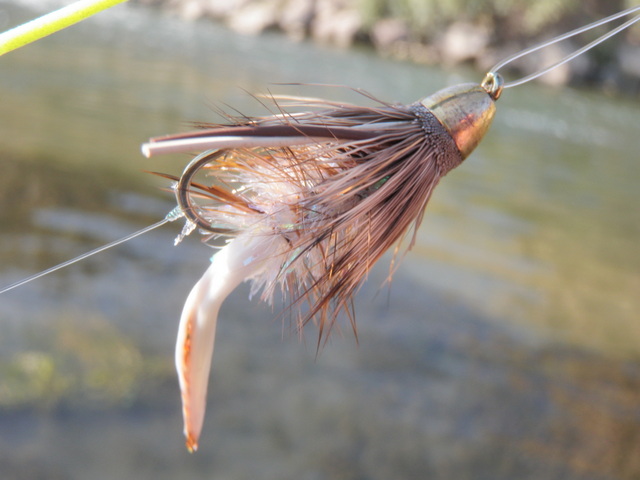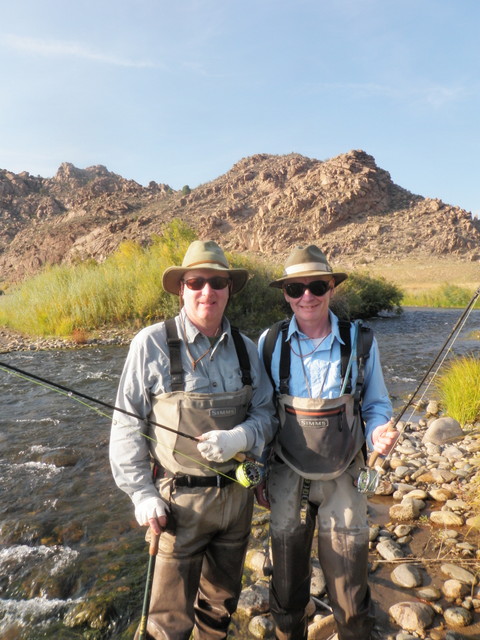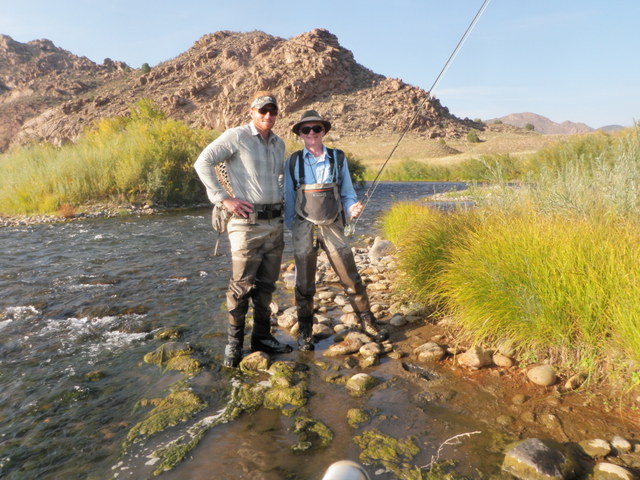Time: 10:00AM – 5:00PM
Location: .2 miles below Fremont – Chafee County line
Fish Landed: 16
Arkansas River 05/04/2013 Photo Album
A month or so ago Dave Gaboury and I made plans to go fishing on the weekend of May 3-5, and we both agreed that the delayed advancement of the caddis hatch due to a cool spring made the Arkansas River the place to be. I took responsibility for lodging and booked us for Friday and Saturday night at the Hampton Inn in Salida, CO. Dave and Beth arrived a bit earlier than expected on Friday night from Kansas City, and we stopped for dinner at the Cherry Tomato in the Park Hill section of Denver. After that we were off on our journey to Salida while Beth navigated to Castle Pines to spend the weekend with some friends.
Saturday morning we ate the continental breakfast at the Hampton Inn to save time and then visited the ArkAnglers fly shop in Salida. The salesperson in the shop was quite bullish on our chances of encountering a decent caddis hatch, and Dave G. purchased some recommended flies. Once we were satisfied with our supply of flies and accessories, we jumped in the Santa Fe and drove east along the river. I was targeting my favorite spot; the boundary of Chafee and Fremont counties, but when we arrived there were three or four cars in the pullout with quite a few fishermen pulling on their waders and rigging their rods, so I proceeded another .2 mile or so and parked in a short pullout in front of a guard rail facing west. I knew we were below the small island that I regard as my favorite spot on the Arkansas River and hoped we could work our way up the river to that location.
The air temperature was probably in the low 50’s but sunny as we prepared to fish, so I zipped on my raincoat to serve as a windbreaker and add a bit of warmth. This proved to be a good move as I wore it the remainder of the day and never felt overdressed and in fact I was quite happy to have it on during several periods of overcast skies and wind. Dave G. and I dropped down a worn path to the river and then decided to cross to the north side of the river, and Dave G. elected to explore going upriver and I went downstream. I’d fished this stretch previously, but never from the north side. After hiking down the bank for 200 yards I cut down to the river a comfortable distance above the next pair of fishermen.
After hearing the reports at the fly shop, I decided to rig up initially with an indicator, split shot, beadhead bright green caddis pupa and a RS2 assuming that I was covering the two most prevalent food sources in the river. It didn’t take long before I lofted the nymphs directly upstream tight to the bank and as they drifted back toward me, I noticed a subtle pause in the indicator and lifted and set the hook in a nice 14″ brown trout. Unfortunately this was not a harbinger of things to come as I continued working the nymphs over the next 1.5 hours with no additional success. All manner of presentation were tested…dead drift, across and down swing, jerky mends, and jigging action on upstream casts.
Dave G. and I had agreed to meet again at 11:30 at the river crossing point, and this worked out nicely as Dave was already there and fishing a nice deep run slightly above the crossing point. I watched Dave G. land a nice rainbow and then snapped a photo of him holding his catch. Dave reported that he was having success with a bright green caddis larva so I swapped the RS2 for a go2 caddis as it sports a bright green body. I decided to cast to a nice deep slot between the shore and a fast run that was 10-15 yards above Dave. Talk about instant gratification; in short order I was attached to a very nice fat rainbow that approximated 15 inches. This renewed my optimism so I advanced up along the north bank to some attractive deep runs below the small island and my revered small right braid.
I worked the double caddis combination through the normally productive deep runs below the island, but the fish were apparently not interested or focused on a different food morsel. When I reached the very bottom of the braid to the right of the island, I decided to change my approach in recognition of the smaller clear water, and removed the indicator and split shot and tied on a Chernobyl ant. I kept the two caddis flies in place as droppers off the Chernobyl ant. The first shallow run at the tail of the channel didn’t produce, but I shot a long cast to the top of the next long shallow pocket behind an exposed rock, and as the ant drifted halfway through the pocket, it paused and I set the hook. A nice brown trout torpedoed out of the pocket and made a futile attempt to escape. The brown was fooled by the bright green caddis and I now had only three fish landed on the morning, but each was a beauty in the 14 – 15 inch range. At this point I decided to return to Dave G. for lunch as I knew that if I worked further up the right braid I couldn’t stop. In addition more time might allow a hatch to develop before I returned to my holy water.
Dave G. and I grabbed the sandwiches we purchased at Safeway in the morning and found perches atop the high rock wall just below the car. After lunch I asked Dave if he fished the small braid around the island and he said no, it was too small, so I asked if he would mind if I fished it. He indicated no problem so we agreed to meet again at the car at 2PM and I set off to my end point before lunch. When I arrived at the bottom of the right braid I positioned myself at the very tail of the nice long forty foot pool just above the small pockets I fished before lunch. I began with some short casts above the tail with the Chernobyl/dropper combination, but almost immediately I began to notice rising fish. The sky had darkened and the wind picked up and I saw occasional caddis tumbling on the surface in the wind, so I was about to tie on an olive brown deer hair caddis. But wait a minute, now I began to see little BWO’s riding on the surface, and there appeared to be more of them than caddis. In addition the riseforms in the pool were tiny sipping rings, and these are not typical of caddis rises.
I clipped off the dry dropper flies and tied on a size 22 CDC BWO and observed four or five fish rising on a fairly regular basis. After quite a few casts I fooled a decent 13 inch brown that engulfed my fly directly upstream and just to the right of a large submerged rock. After I released this fish, I began to notice more regular rises in the small current seam that ran through the center of the pool, so I began running my fly along this slow moving current. Initially I pricked a pair of trout and then several refusals added to my frustration. Finally a trout sipped my imitation, but in my zeal to land one on a dry, I set too hard and snapped off the BWO. Next I swapped out my CDC BWO several times as I strived for one with a smaller wing profile.
It took quite a few casts but eventually I noticed a subtle sip on my fly and set the hook. An explosion ensued as a fat brown blasted above the surface and crashed in the pool like a swimmer executing a cannonball. The bruiser moved up and down the pool several times but I eventually applied side pressure and slid my net gently beneath the wide body. What a sag it created! After taking a photo I knelt to remove the fly and noticed it was embedded in the hard lip of the trout with only a tiny 1/8 inch space between the hook and the outside of the bony lip. It was quite a thrill to land this 16″ fat brown on a size 22 CDC BWO.
Unfortunately the fight with Mr. Brown scattered the other rises in the pool and while I dealt with my prize, the sun reappeared and the sky brightened and the BWO’s were no longer evident on the surface of the water. I paused before resuming my fishing and tried to spot rises in the top two thirds of the pool or even in the next short pockets, but seeing none I decided to convert back to the Chernobyl ant with a beadhead bright green caddis pupa dropper and then a second fly below that, a Craven BWO soft hackle emerger. I didn’t want to prospect the remainder of the delicious right braid in front of me with the tiny CDC BWO if no fish were visible rising to the surface.
The cycle of heavy clouds, darkened sky and increased wind followed by sun and brighter skies would play out repeatedly over the remainder of the afternoon. Each period of cloud cover and wind was accompanied by another wave of BWO emergence, although they became shorter in duration and the fish didn’t seem to tune in as much to the subsequent hatches.
Meanwhile with the end of surface feeding I again made the conversion to the dry/dropper approach, and it proved to be a stroke of genius. Over the next hour or so I worked up the right channel next to the island and landed six additional fish with perhaps half being rainbows and half browns, and these were not the average run of the mill twelve inch Arkansas River fish. They were bruisers and averaged in the 14-16 inch range. It amazed me how nearly every little pocket and nook produced fish, even spots that I normally would skip, and there were a few refusals and momentary hook ups mixed in with the six landed fish. It was insane how many above average fish this small channel delivered over an hour of fishing, and I didn’t even fish out the entire stretch as I realized I was late to meet Dave G. at our prearranged time of 2PM.
I quickly reeled up and hooked my flies to the guide and skipped to the top of the island and then crossed to the south side between two fishermen, and then practically trotted in my waders to the car. No Dave. Now what should I do? I shouted a few times and hustled down to the large rock overlooking the river where we ate lunch so I could look down the river. Seeing no Dave I remembered he had passed by me on the left side of the island next to the channel where I’d experienced a great hour of fishing, so I decided to walk up the road and scan the river as best I could looking for Dave. I ended up at the pullout at the Chafee – Fremont county line, and hadn’t seen him so I decided to resume fishing although I was feeling guilty about missing our appointment.
I crossed the river at the tail of the long pool by the county line and climbed the bank and walked down the railroad tracks toward the top of the island ahead of where I ended at 2:15. One of the fishermen I’d split on my crossing was now above the braid I was fishing so I cut down to the bottom of a long wide riffle that I like. Sure enough there was Dave G. on the opposite side, and I was quite relieved to find him. He had returned to the car before me, and when I didn’t arrive he returned to the place where I now found him.
It was now 2:30PM and we went through a period of bright skies, but this didn’t last long before clouds moved in and another smaller BWO hatch commenced. I never bothered to switch to dries and kept working the three fly system. In a nce V behind a protruding rock near the top of the riffle the ant paused, and I set the hook and played and landed a nice 13 inch rainbow. For some reason the later mid-afternoon hatch as well as one that lasted longer and began around 4PM did not bring as much action or surface feeding as the first emergence of the day.
I continued moving up along the right bank and eventually discovered a method that yielded three additional fish. I positioned myself eight feet upstream of a large boulder and cast across and allowed my flies to drift downstream and then swing across the cushion that existed in front of the large boulder. Two rainbows and a small brown fell for this ruse and attacked the trailing soft hackle emerger like it was an escaping BWO. I also experienced three or four momentary hook ups using this method. In one memorable case I thought I spotted a faint movement of a silvery ghost a foot below the surface and in front of a rock and slightly to the outside. I made a couple casts that swept short of the mark, but when I executed one with a bit more distance, I saw the ghost emerge and set the hook and felt a momentary weight. While I didn’t land this fish, it was gratifying to spot the movement and then have success with my method. This one got away but I was having enough success to keep things interesting.
Towards the end of the afternoon I was surprised to dupe a thirteen inch brown on the Chernobyl after flipping a backhand cast into some deep water behind a huge vertical rock that formed a barrier to my progression. After this I climbed up and around the rock and spotted some rising fish on the upstream side as a late afternoon BWO hatch reconvened. I managed to land a sixteenth fish on the soft hackle emerger but then switched to the CDC BWO to attempt to fool the risers. Unfortunately the wind picked up and blew straight up the river so that when I cast across the wind just shot my fly upstream and removed any intended slack. In addition I had no idea where the tiny gray winged fly was landing. When I tied on the CDC BWO I noticed a tiny nick in my leader about an inch above the hook eye, but I stupidly chose to ignore it.
I finally got the idea to move below the risers and angled some casts above and to the left of the rise. This worked better for compensating for the wind and sure enough I spotted a rise to my fly. I set the hook and felt the weight for a split second and then it was gone. You guessed it, I reeled up and the line snapped at the point of the nick or abrasion. On that note Dave and I called it quits and returned to the Hampton Inn. It was a fun day and the hour and a half between 1PM and 2:30PM was perhaps the best of the year so far.

